Curb Your Appetite
September 16, 2016 Published ~ 8 years ago.
Casein Protein Is Way Underrated. Here’s the Proof
Casein is a slow-digesting dairy protein that people often take as a supplement. It releases amino acids slowly, so people often take it before bed to help with recovery and reduce muscle breakdown while they sleep. Several studies have shown it helps boost muscle growth, along with a ton of other benefits. Like Whey, Casein […]
The article “Casein Protein Is Way Underrated. Here’s the Proof” appeared first on AuthorityNutrition.com
September 15, 2016 Published ~ 8 years ago.
How to lose weight.

No, really.
I used to be overweight. Not just a little. When I’d walk down the street, people would go “Damn, that’s a fat ….” (you can fill out the dots with some creative swearing. I’ve heard them all).
At my highest level of corpulence, I weighed in at a 145 kilograms, which equals about 320 pounds for everybody on the other side of the Atlantic. I’m roughly a 193 centimeters tall (6.3 feet), which left my BMI at an alarming 38.9 (with 30 being the “obese” level). So the people on the street were more than right.
People often ask me how I got so corpulent. My answer isn’t laden with lame excuses. Not anymore at least. I became a pot-bellied burger gobbler because I ate. I ate a lot. I ate a lot, and as often as I could.
No exercise apart from walking a couple of feet to school, university or the supermarket. I can’t exactly recall when this started, but by judging photographic evidence it started during my tween years. And from that point in time I just grew, and grew, until one day I lifted my chubby feet onto the scale for the first time in years. And then it hit me.
You will die of heart disease or worse before your 30th birthday.
You could read the entire artilce where it was first published on Medium here: https://medium.com/gethealthy/how-to-lose-weight-32780698232#.gi0dkl772
image was also obtained from the same Medium account : https://medium.com/gethealthy/how-to-lose-weight-32780698232#.u76w9bnex
September 15, 2016 Published ~ 8 years ago.
The Real Reason We Get Fat
Here’s a news flash for ya…Your ass being big has nothing to do with food.Now if you only have 10-15 pounds to lose, this article may not pertain to you. Most people who are only a few pounds overweight often find that a new lifestyle change has gotten their schedules (and bodies) out of whack.Possibly a new job, a move, or simply some extra holiday indulgence is the reason for their pants being snug lately. This article is about obesity. It’s about how us fat people get fat.
When I was morbidly obese (262 pounds, 5′4″ tall), I would always say that it was because I loved food. Being on the other side of my weight loss journey, I know for certain that was a bunch of horse shit. Yes, I loved food. That part wasn’t a lie. I loved food then and I love food now. But my love for food wasn’t WHY I was fat.
Why did I get fat?
The real reason I was fat? It’s simple really.
PAIN.
Pain was the reason I got fat.Everyone has pain. Everyone. And everyone has different pain. Pain for a million different reasons and even more combinations. Some people choose healthy and productive ways to deal with pain and some people don’t. I was one of those people in the ‘don’t category’.
This entire article can be found over here: http://halfofgabby.blogspot.com/2016/07/the-real-reason-we-get-fat.htmlhttp://halfofgabby.blogspot.com contains even more great personal revelations and help.
This article goes on with amazing truths that have nothing to do with actual eating and yet affects our eating greatly. Our attitudes make such an impact on what we eat. And how much of it we stuff in our mouths.
I appreciate others with the courage to share their story. Learning what is behind weight gain can be freeing.
I strongly encourage you to read this article. It is full of beauty in attitude tips. Let’s lose it naturally!
September 15, 2016 Published ~ 8 years ago.
Turmeric: 12 Practical Uses for this Powerful Spice

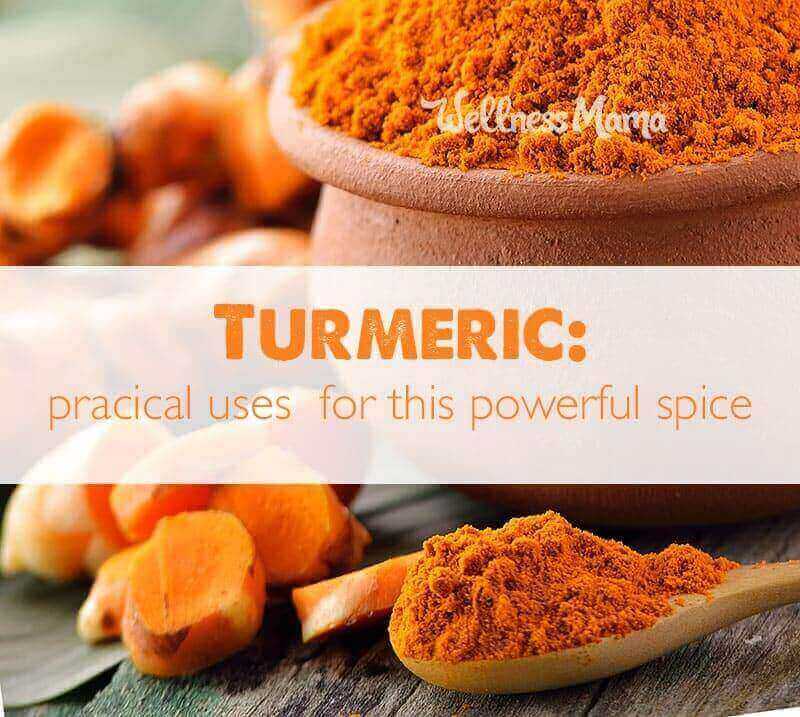
Turmeric is a powerful spice with an impressive list of uses and benefits. It’s known for its antioxidant content and ability to work as an anti-inflammatory. This common culinary spice is prized in many cuisines around the world and with good reason.
What’s So Great About Turmeric?
In short…. a lot:
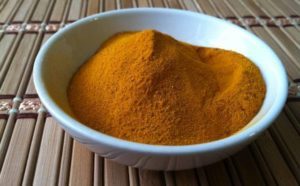 The spice we refer to as Turmeric is actually the dried and ground rhizome of a plant in the same family as ginger. It is used and prized for its color and earthy flavor in culinary traditions around the world. Modern medicine recognizes its health benefits and it has been used extensively in natural and folk medicine for centuries.
The spice we refer to as Turmeric is actually the dried and ground rhizome of a plant in the same family as ginger. It is used and prized for its color and earthy flavor in culinary traditions around the world. Modern medicine recognizes its health benefits and it has been used extensively in natural and folk medicine for centuries.The benefits attributed to this bright yellow spice are often the result of the curcuminoids it contains. The most common curcuminoid is curcumin, which is now available as a supplement and in many remedies. While turmeric has many benefits, it is only about 3% curcumin by weight, and often more concentrated curcumin supplements are used.
Benefits of Turmeric
Largely due to its curcumin content, Turmeric is often credited with these benefits:
- Fighting inflammation
- As an antioxidant
- Protects the heart in various ways
- Helpful for arthritis
- Brain boosting
- May be helpful for fighting diabetes and cancer
Turmeric + Black Pepper
If you’ve researched Turmeric at all, you may have seen that many supplements and recommendations also include black pepper as well. Black pepper contains piperine, which has been shown to dramatically increase the absorption and effects of turmeric.
Personally, when I use turmeric for cooking or natural beauty recipes, I make sure to add a little black pepper as well for this reason.
Cautions about Turmeric Use
Turmeric is generally considered safe for use in medicinal amounts, but it is important to talk to a doctor before using this or any substance medicinally as it can interact with several medications.
Practical Uses for Turmeric
There are entire websites and books dedicated to the use of “superfoods” like this ancient spice for medicinal use. Personally, I think all of these substances are the most beneficial when they are a small part of an overall healthy diet and lifestyle. Rather than taking large quantities of any supplement or spice, I work small amounts into my daily life in these ways:
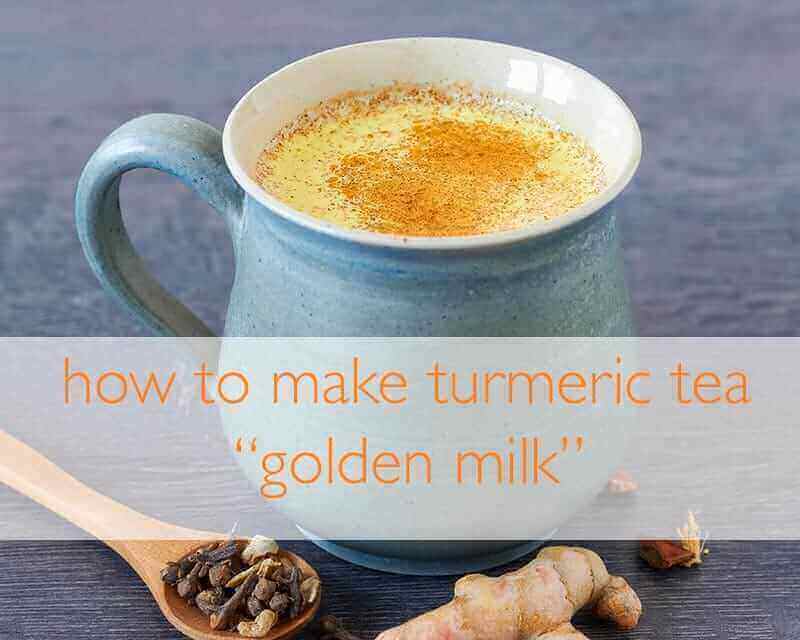
1. Turmeric Tea aka Golden Milk
The name is slightly misleading, but this “tea” is a blend of some kind of milk (including almond milk or coconut milk), spices and optional sweetener. Currently, I enjoy this with homemade pecan milk for a deep, earthy flavor. We drink these often during winter months as a satisfying warm beverage and to help ward off illness. See the full recipe here.
TIP: Using a fat soluble base like milk or pecan milk increases the absorption of the turmeric. The addition of a pinch of black pepper increases the absorption of the turmeric. I also like to add some liquid vanilla stevia instead of other sweeteners for a slight sweetness without the sugar.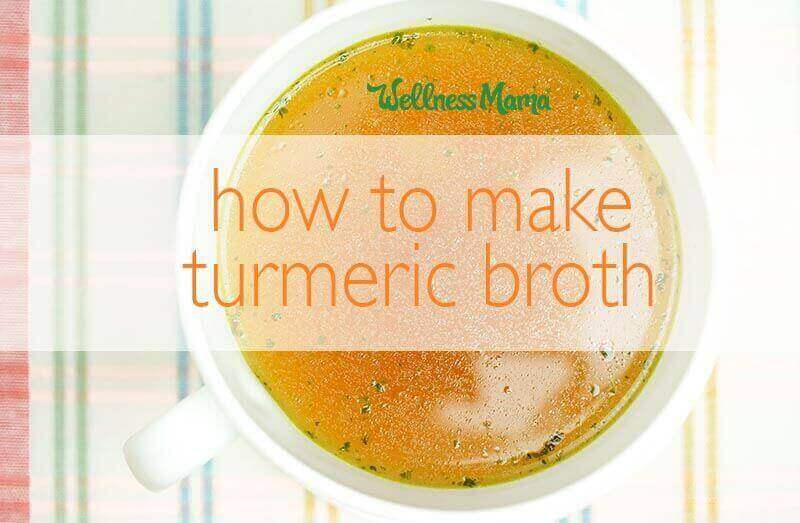
2. Turmeric Broth
If the Golden Milk drink above isn’t your thing or if you prefer a more savory warm drink, turmeric broth is a great alternative. Instead of a milk or milk alternative, the base of this drink is broth (here’s how to make your own).
Turmeric Broth RecipePrep timeCook timeTotal timeA simple and delicious turmeric broth adds antioxidants and amazing flavorAuthor: Wellness MamaRecipe type: SoupServes: 4 cupsIngredients- 4 cups of broth
- 1 teaspoon of turmeric powder or freshly grated turmeric
- 3 cloves of minced garlic
- 1 tablespoon of finely grated fresh ginger (optional)
- 1 tablespoon of apple cider vinegar
- ½ teaspoon each of cumin, black pepper and salt.
Instructions- First, place all the ingredient sin a small saucepan.
- Then, simmer the mixture for about five minutes.
- Finally, blend with an immersion blender (optional) and enjoy.
NotesAny herbs or spices work and can change up the flavor of this recipe.TIP: This is also a great base for soups or stews. To make a 5-minute nutrient-packed egg drop soup, crack four raw eggs into the broth above as it is simmering while whisking rapidly.
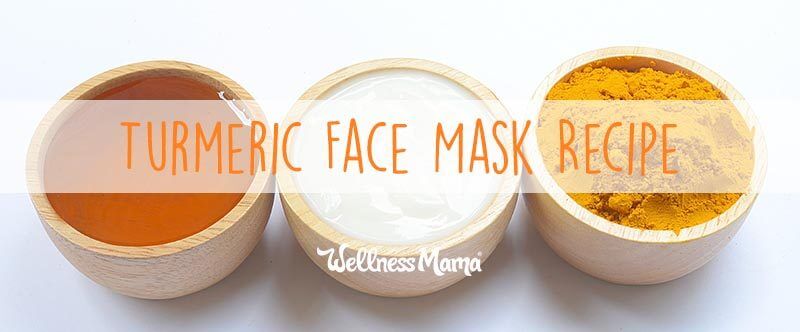
3. Soothing Face Mask
Turmeric can also be used on skin! One of my favorite ways to use it is in a face mask. You can add 1/2 teaspoon of turmeric powder to any face mask recipe you love.
My favorite recipe: Mix 2 tablespoons of unsweetened yogurt with 1/2 teaspoon of turmeric and 1 teaspoon of honey for a soothing and cooling face mask. I leave it on for about 5 minutes and wash off. (I’ve never had problems with it staining skin, but use an old towel just in case.)
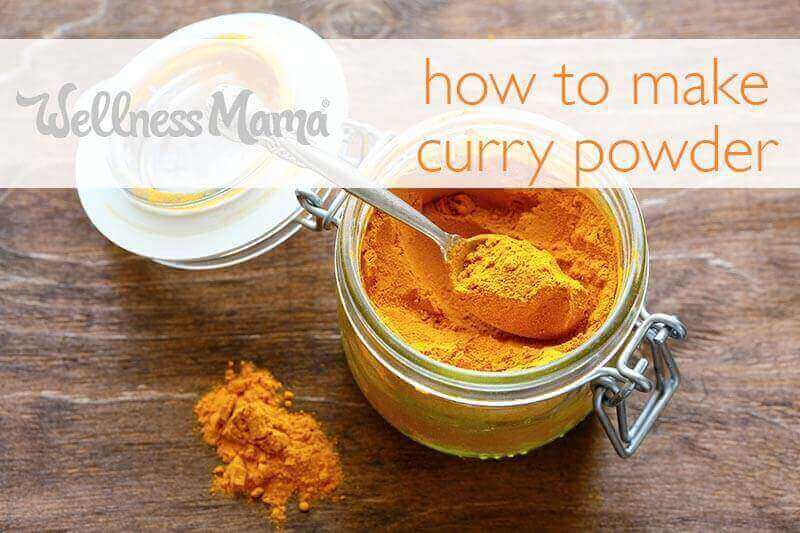
4. Curry Powder
This vibrant and earthy spice already has a reputation as a staple in many cuisines and I love cooking with it! One of my favorite ways to incorporate small amounts of this power spice is by making a homemade curry powder. This uses a host of powerful spices and provides awesome flavor to many dishes.
Make your own curry powder with this easy recipe.
5. Sunrise Smoothie
Not all smoothies have to taste like a pina colada. One of my favorite smoothies has a hint of sweet nestled among earthy spices.
To Make: Blend 1 cup of pecan/almond/coconut milk with 1/2 cup frozen pineapple, the juice of one lemon and one orange, 1/2 teaspoon turmeric, a tiny pinch of black pepper, and about a teaspoon of grated fresh ginger root. Add a natural sweetener like stevia if desired.
6. Potent Poultice
Try this spice externally in poultices to sooth skin and reduce inflammation. It is often used in lotions or preparations for skin with eczema or psoriasis for this reason. I’ve personally used this when I’ve twisted an ankle or broken a toe (there is nothing doctors can really do for a toe anyway).
What I did: I made a thick paste of castor oil, turmeric and a small amount of black pepper and rubbed over the inflamed area (in this case, my broken toe). I wrapped with a waterproof wrap and a bandage and left on the toe for a few hours. It didn’t help the bone (of course) but seemed to calm some of the inflammation and reduced my pain. This does stain slightly so I wouldn’t recommend it in visible areas (it will fade after a few days).
7. Acne Gel
Just like in the face mask above, the anti-inflammatory properties of this unique spice makes it beneficial to help cool and stop acne. I make a paste of honey and turmeric (2 parts honey to 1 part turmeric) and dab on to spot treat.
8. Brighten Teeth
I was skeptical about putting turmeric on my teeth since it has such a propensity to stain. I got over my fears pretty quickly after seeing how well it worked for my friend Heather. Here’s how she used it to whiten teeth.
9. Stop the Itch!
I’ve found that a thin paste of aloe vera gel and turmeric can help calm itchy or burned skin. I’ve used this on bites, poison ivy and even eczema with good results. Fair warning… it is messy! For kids, I let them use this right before bathing while they are in the tub to keep the mess down. It only takes a few minutes to help cut the itch/pain so I read them a book and let them finger paint the turmeric salve on themselves.
10. As a Plain ol’ Spice
Sure, we can think of creative ways to use it, but this simple spice is great when added alone to many dishes. I like to add it to eggs, roasted veggies, meats, and soups for a wonderful flavor.
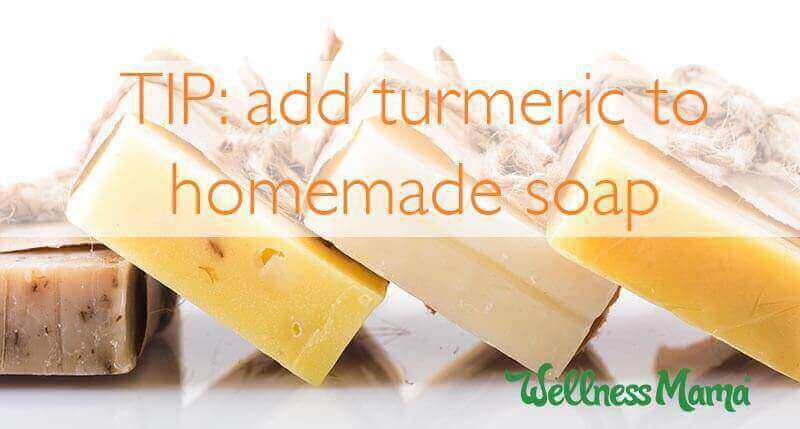
11. Spice Up Your Soap
If you make your own soap, add turmeric for color and for skin benefits. If you don’t make your own soap, you should give it a try! It’s a lot easier than you’d think (here’s a super simple cold process recipe). This spice makes a beautiful colored soap that can be especially helpful for soothing irritated skin.

12. Golden Honey
Have trouble getting kids to like this potent spice? It is such a great remedy and can help soothe a sore throat, but kids don’t love the taste. My solution? Neon yellow cough syrup (at least that is what my kids call it). I add 3 tablespoons of powdered turmeric to an 8 ounce mason jar of honey (about 1 cup of honey). By definition, this is actually an electuary, but my kids just think of it as a brightly colored honey that helps their throats feel better. This can be made ahead of time and stored for a very long time since both ingredients are shelf stable.
Turmeric: What to Avoid
This powerful root has many benefits, but also a few important cautions. As I mentioned, it is very important to talk to a doctor before using it as a remedy for those who have any medical condition or who are pregnant or nursing. Culinary use is generally considered safe.
Some folklore info suggests that it was used as a birth control and it should not be taken by women who are pregnant or trying to become pregnant (though using it in cooking is fine). When used externally, it will give the skin a light yellow hue for a little while after use and this can easily be washed off.
Sources disagree about using turmeric in hair. Some say that it helps improve hair and stop dandruff, while others swear it is a natural way to remove hair. I haven’t found strong enough evidence for the potential benefits in hair to make me brave enough to try it though.
Where to Get It
There can be a tremendous difference among different brands of Turmeric. I purchase Turmeric in powdered form here as it is the best value and I am extremely impressed with its quality. You may also be able to find high quality Turmeric locally, just look for organic with bright yellow orange color and no added ingredients.
Do you cook with Turmeric? Ever used it for other uses? Please share below!

Continue Reading…Turmeric: 12 Practical Uses for this Powerful Spice
September 15, 2016 Published ~ 8 years ago.
Does Fiber Relieve or Cause Constipation? A Critical Look
Constipation is a common problem that affects up to 20% of people every year (1, 2). It’s a difficult condition to define, as bathroom habits vary considerably from person to person. However, if you have less than three bowel movements a week and your stools are hard, dry and difficult to pass, you’re likely constipated. […]
The article “Does Fiber Relieve or Cause Constipation? A Critical Look” appeared first on AuthorityNutrition.com
September 14, 2016 Published ~ 8 years ago.
How Knowing Your Chronotype Can Improve Your Sleep


When I met Oprah’s sleep doctor, Dr. Michael Breus, at a recent event, I knew I had to have him on the podcast to share his information. He’s the author of the wildly popular new book, The Power of When, and in this episode, he explains why “night owl” and “early bird” are outdated terms and how to know your chronotype (natural way you sleep).
The Power of When
I have read and researched a lot about sleep over the years and consider myself pretty well-versed in the basics of good sleep. Talking to Dr. Breus, I understand why both Oprah and Dr. Oz trust him with their sleep. He is not only incredible knowledgeable about how to get better sleep, but also how to use your sleep type to be happier and more productive during the day.
If you aren’t familiar with him:
Michael J. Breus, Ph.D., is a Clinical Psychologist and both a Diplomate of the American Board of Sleep Medicine and a Fellow of The American Academy of Sleep Medicine. He was one of the youngest people to have passed the Board at age 31 and, with a specialty in Sleep Disorders, is one of only 163 psychologists in the world with his credentials and distinction.
Know Thy Chronotype
According to Wikipedia:
Chronotype refers to the behavioral manifestation of underlying circadian rhythms of myriad physical processes. A person’s chronotype is the propensity for the individual to sleep at a particular time during a 24-hour period.
Take this fast quiz to find out what your chronotype is. This will make this podcast episode make a lot more sense, and will also shed some light on your own sleep patterns.
Instead of the outdated “night owl” and “early bird,” chronotypes, Dr. Breus has broken different sleep types into four chronotypes based on his experience with patients. These chronotypes are:
- Dolphin
- Lion
- Bear
- Wolf
Light Matters for Good Sleep
I’ve written a lot about how light impacts quality. This is the reason I personally wear orange sunglasses at night to avoid blue light and why my kids don’t have a night light (one of the posts I’ve gotten the most negative response to).
I asked Dr. Breus’ opinion on the issue and he provided some important insight and context.
In The Power of When, he says:
The most disruptive event in the history of biotime occurred on December 31, 1879 with the invention of the electric light bulb.
Pretty strong statement, huh?
In this episode he explains how artifical light directly impacts circadian rhythm and how light at night can suppress melatonin production.
Children and Sleep
In this episode, I also asked Dr. Breus’ opinion on much of the common sleep advice for babies and children, and some of his answers surprised me. Listen to the episode to hear them all, but we talk about:
- How babies don’t make melatonin for the first 3 months. They get it from breastmilk but this is why they often need to nurse every few hours at night the first few months to get enough melatonin to keep sleeping.
- The best time, based on sleep biology, to establish a sleep routine with babies.
- Why children should NEVER be given melatonin supplements and the dangers of melatonin even for adults (did you know it is a contraceptive?)
- The best time to drink coffee (and it isn’t first thing in the morning).
- Why lunch should be the biggest meal of the day.
- Why you should drink a quart of water (or lemon water) first thing in the morning
- How sleep is more important than exercise
- The reason you should probably let your teenager sleep in as long as possible
Resources We Mention:
- Book: The Power of When
- Quiz: Know Your Chronotype
- Light bulbs: Lighting.science
Do you struggle with sleep? What has helped you?
Continue Reading…How Knowing Your Chronotype Can Improve Your Sleep
September 14, 2016 Published ~ 8 years ago.
Authentic Homemade Pasta Sauce (Fresh or Canned Tomatoes)

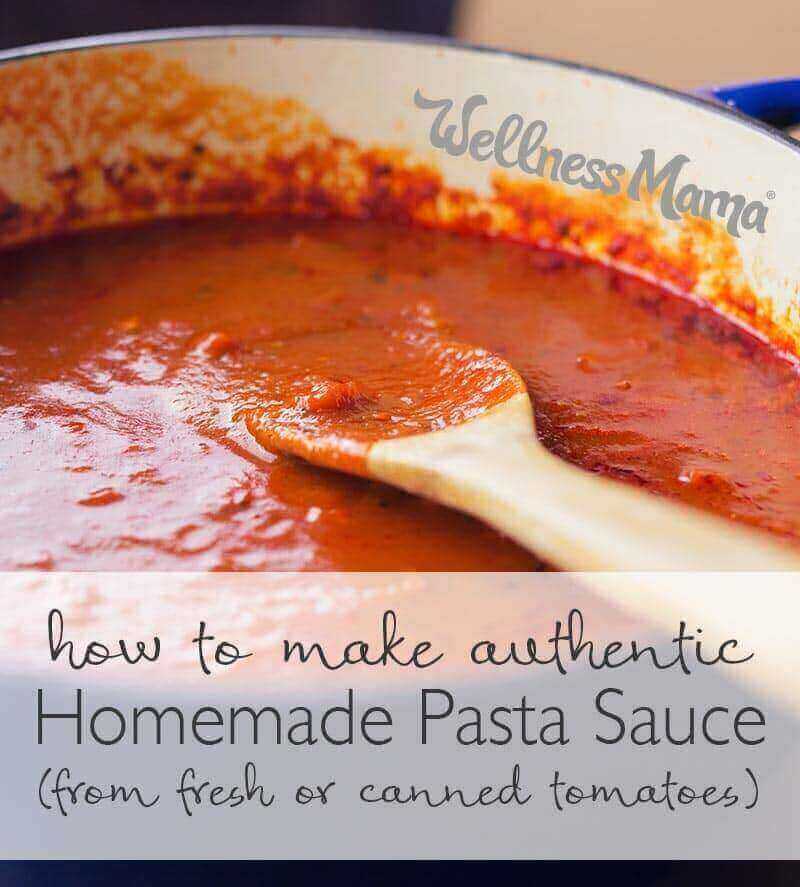
I married into an Italian family, and as such, several things are a given:
- Family gatherings will be loud
- There will always be a faint aroma of basil and garlic in the house
- Learning to make a delicious and authentic homemade pasta sauce is high on the to-do list for a new wife
Why Homemade Pasta Sauce?
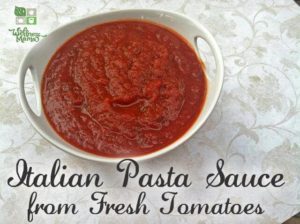 When I married into the family, I became privy to Nonna’s (my husband’s grandmother) pasta sauce recipe that uses pre-canned tomato sauce and diced tomatoes (that she probably canned herself). One year I attempted to mimic the recipe using fresh tomatoes since we had an abundance from our garden and came up with my own pasta sauce recipe.
When I married into the family, I became privy to Nonna’s (my husband’s grandmother) pasta sauce recipe that uses pre-canned tomato sauce and diced tomatoes (that she probably canned herself). One year I attempted to mimic the recipe using fresh tomatoes since we had an abundance from our garden and came up with my own pasta sauce recipe.I’m sharing my variations of both today:
How to Make Pasta Sauce from Fresh or Canned Tomatoes
I you are working from fresh tomatoes, use the first recipe. If you are using canned tomatoes, use the second.
While “Nonna’s Recipe” is still the gold standard of pasta sauce in our family, I’m not sure I’m allowed to share the secret recipe so I’m sharing my variations instead. I know that I can share one part of her secret, which is to throw a piece of a carrot into the sauce while it is cooking to absorb the acidity of the tomatoes and create a sweeter sauce. This also removes the need for a sweetener to cut down the acidity.
Homemade Pasta Sauce from Fresh Tomatoes
Homemade Tomato SaucePrep timeCook timeTotal timeAuthentic tomato marinara sauce from fresh tomatoes, basil and garlic.Author: Wellness MamaRecipe type: SauceCuisine: ItalianServes: 6-8Ingredients- 5 pounds of fresh tomatoes, peeled and seeded (to peel, cut a small “x” on the top and drop in to boiling water for 10 seconds and drop in to an ice bath. Skin will easily peel off)
- ¼ cup olive oil (or tallow)
- 3 medium onions, diced
- 8 cloves of fresh garlic (or more to taste), finely minced
- ⅓ cup fresh basil leaves, finely chopped
- 1 sprig of fresh thyme leaves (or ½ tsp dried)
- 1 sprig of fresh oregano (or 1 teaspoon dried oregano)
- 2 bay leaves (remove when done)
- 2 sprigs of parsley (or 1 tsp dried)
- 1 teaspoon sea salt
- 1 carrot (1/2 should be grated and added to sauce, the other half should be added at the end of cooking and then removed)
- Optional: 1 tablespoon honey
Instructions- Pour the olive oil into a large stockpot over medium heat.
- Add diced onions, garlic and grated carrots.
- Saute for 6-8 minutes or until onions are translucent and tender.
- Add tomatoes, chopped basil leaves, oregano, thyme bay leaves, parsley and sea salt.
- Simmer on low heat for 2-3 hours or until cooked down and starting to darken.
- Add carrot piece for the last 30 minutes to absorb acidity.
- Remove sprigs of herbs and piece of carrot.
- Optional: Use an immersion blender to puree sauce until smooth (for a thicker sauce, skip this step.
- Use fresh or store in the fridge up to 1 week, or can it according to your canner’s instructions for tomato products.
10-Minute Pasta Sauce from Canned Tomatoes
If a two-hour simmer time isn’t your thing, this 10-minute recipe tastes almost as good and cooks in much less time. This is my go-to on a busy night when I have 20 minutes to turn a pound of ground beef into dinner. We serve with zucchini or other vegetable noodles for a great flavor.
Ingredients:
- 2 medium onions, chopped
- 8 cloves fresh garlic, minced
- 1/4 cup olive oil
- 2 (28-ounce) cans or jars of whole, crushed or stewed tomatoes (or 4 15-ounce cans)
- 1 (6-ounce) can or jar of tomato paste
- 1/2 teaspoon dried oregano
- 1 tablespoon dried basil leaves (or 1/4 cup fresh, finely chopped)
- 2 bay leaves (optional)
- 1/2 teaspoon dried thyme (optional)
- salt and pepper to taste
Instructions:
- Heat the olive oil in a medium size pot over medium heat. Add onions and saute until soft, about 5 minutes
- Add garlic and saute another minute.
- Then, add tomatoes, tomato paste, oregano, basil, bay leaves, thyme and salt/pepper.
- Bring to a boil and immediately reduce to a simmer.
- Simmer for 10-15 minutes to let flavors meld. (Can simmer longer if desired for a thicker sauce with a deeper flavor).
- Serve over pasta of choice.
- Optional: for a thinner sauce that works better for pizza, chicken parmesan, etc, use an immersion blender to blend until smooth.
How to Use Homemade Pasta Sauce
You probably already have a recipe in mind since you’re reading this post, but this is endlessly versatile and great in many recipes. The fresh tomato recipe variation is great for tomato season, and I often can any extras to use in the winter.
I use this sauce in:
- Homemade meat sauce by adding 1-2 pounds of browned ground beef and serving over zucchini or shirataki noodles
- Zucchini Lasagna
- Meatza
- Chicken Cacciatore (in place of the tomato sauce/paste/spices)
- Chicken Parmesan
- etc.
How to Can Your Own Pasta Sauce
You can easily make a large batch of either of these sauces and can it for future use. I often do this when we have an abundance of tomatoes from the garden. There is really no reason to can the recipe made from canned tomatoes, since it is so quick to whip up and there is no need for the extra step.
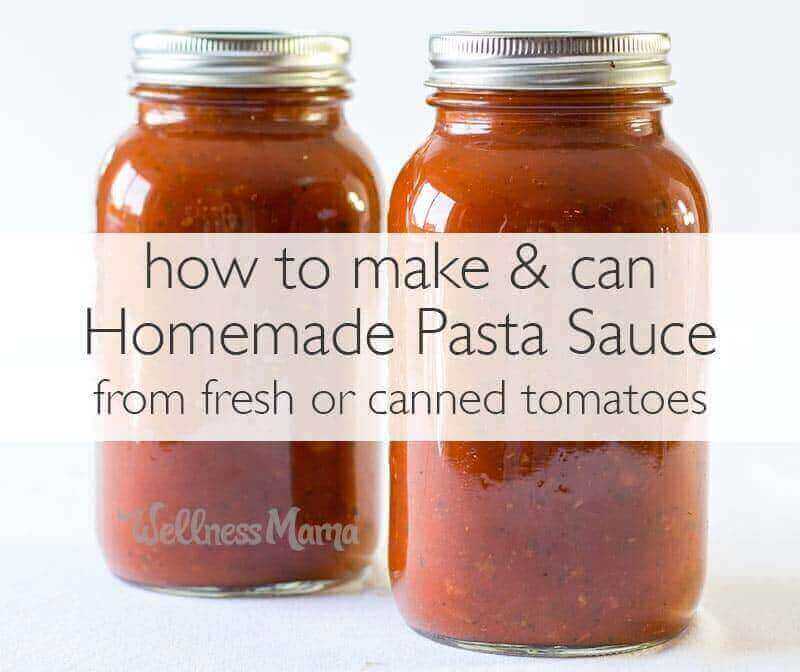
Canning Instructions for Homemade Tomato Sauce
I follow these instructions for canning my homemade tomato sauce. There is some debate if it is ok to water bath can tomato products or not. The general consensus seems to be that tomatoes are iffy for water bath canning because the pH is not quite acidic enough. One solution is to add 1 teaspoon of lemon juice per quart for canning or check the pH to make sure it is 4.4 or below.
Personally, I prefer to just pressure can according to my pressure canner instructions as the pressure is enough to kill any botulism spores and is considered safe for tomatoes.
How to Freeze Homemade Tomato Sauce
If canning isn’t your thing, you can also freeze this homemade sauce. I like to freeze in quart size glass mason jars (here’s how) or metal containers, to avoid plastic. You can also freeze this sauce in any container once it has cooled.
Featured Download: Pasta IS Healthy! Download a complimentary copy of my Grain Free Italian Digital Recipe Book of nutrient-dense Italian favorites. Send it to Me!Do you make your own pasta sauce or use the store-bought canned variety? Share below!

Continue Reading…Authentic Homemade Pasta Sauce (Fresh or Canned Tomatoes)
September 14, 2016 Published ~ 8 years ago.
Should You Avoid Fish Because of the Mercury?
Fish is one of the healthiest foods you can eat. That’s because it’s a great source of protein, micronutrients and healthy fats. However, some types of fish can contain high levels of mercury, which is toxic. In fact, mercury exposure has been linked to serious health problems. So what should you do? Does it mean […]
The article “Should You Avoid Fish Because of the Mercury?” appeared first on AuthorityNutrition.com
September 13, 2016 Published ~ 8 years ago.
Wine: How to Get the Benefits (Without the Downsides)


Wine: Drink half a glass per child, per day.
That was the answer a mom of many children gave me when I asked how she did it all several years ago. Of course, she was saying that she drank half a glass per day for each child she had (not that she gave it to the kids… in case that was unclear). And she was half joking (but only half) since with the number of kids she had, she would have been drinking more than a bottle a day.
Reasons to Drink Wine
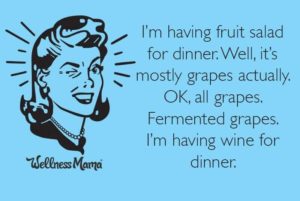 The fruit of the vine is a natural choice to accompany almost any meal. There is quite literally a wine for every occasion.
The fruit of the vine is a natural choice to accompany almost any meal. There is quite literally a wine for every occasion.Internet memes abound about the stress-relieving effects of this delicious beverage. Gag-gift funny products joke about its benefits, from wine bottle size glasses, to coffee mugs that declare:
Lord, give me coffee to change the things I can, and wine to change the things I can’t.
All joking aside, it has been extensively studied for its health benefits and its affect on mood, heart health, and longevity.
Turns out my friend may have been on to something…
Is Drinking Red Wine Healthy?
The short answer? Yes.
You’ve probably seen the headlines over the years about the heart healthy benefits of red wine. These heart benefits have been well-studied. Recent research has uncovered many other benefits to this age-old fermented drink as well.
While red wine traditionally gets all the glory, a recent study showed that white wine may have the same benefits:
Past studies indicated that the cardioprotective compounds in grapes polyphenolic antioxidants reside in the skin and seeds. Grape skins, which contain purple pigment, are crushed with the pulp to make red wines. But the skins are separated from the pulp to make most white wine. That situation led to the conventional belief that red wines and red grape juice are the most heart healthy…
“To the best of our knowledge, our study provides evidence for the first time that the flesh of grapes is equally cardioprotective with respect to the skins,” the researchers report.
The Reality of Resveratrol
Red wine contains Resveratrol, which is not found in white wine, but recent research has called its benefits into question. The study looked at elderly residents in Tuscany and found no noticeable difference in the Resveratrol levels in the urine of those who lived longer vs. those who didn’t.
Studies about the benefits of Resveratrol have typically looked at how it affects cells in a lab setting. This isn’t necessarily an accurate representation of its role in the body. At the same time, just measuring urine levels may also not provide a clear picture of benefit.
From all of the research I’ve read, I’m not sold on the benefits of Resveratrol, as we’d essentially have to drink wine non-stop and swim in it constantly to reach the concentrations used in lab studies. At the same time, it isn’t the only beneficial compound in wine, and I think there are other benefits far beyond Resveratrol.
These studies also show that no compound, no matter how beneficial, can replace the importance of a healthy lifestyle. Alcohol consumption should just be a small part of an overall healthy lifestyle of a good diet, quality sleep and movement.
How Much Red Wine is Good for your Health?
It is important to note that all of the studies found the most benefit from moderate consumption of wine.
The Dietary Guidelines for Americans define moderate consumption as one glass per day for women and up to two glasses per day for men.
Note: The good news for those who choose not to drink is that it is possible to get many of these same health benefits from other sources (although it will be much less enjoyable to do so
September 13, 2016 Published ~ 8 years ago.
The 18 Best Healthy Foods to Gain Weight Fast
For some people, gaining weight or adding muscle can be just as difficult as losing weight. However, simply adding certain foods to your diet can be very effective to gain weight. Here are 18 of the best foods to help you gain weight or add muscle, the healthy way. 1. Homemade Protein Smoothies Drinking homemade […]
The article “The 18 Best Healthy Foods to Gain Weight Fast” appeared first on AuthorityNutrition.com
Feed Information for Curb Your Appetite
- Homepage: http://feed.informer.com/digests/LLSFOYQT40/feeder
- Feed URL: http://feed.informer.com/digests/LLSFOYQT40/feeder.rss
- Bookmark: http://rss2.com/feeds/Curb-Your-Appetite
- Added by: JessicaLynn
